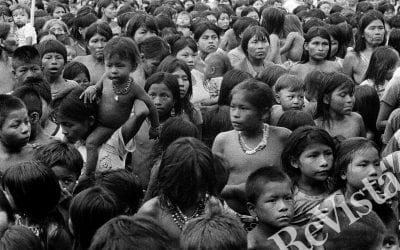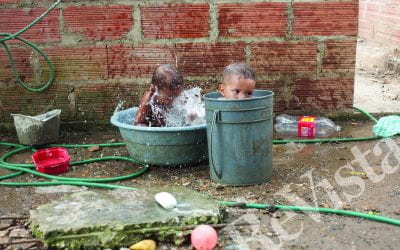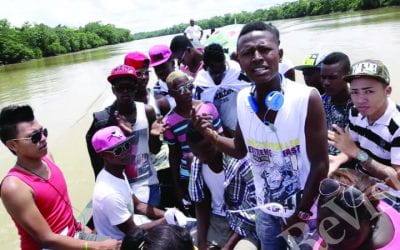Peace Education through Music
As my plane glided down toward the sea, I looked out from my seat at the beaming afternoon sun eclipsed by the rising Corcovado hill upon which stood the mighty Christ the Redeemer. Each time I had come to Rio de Janeiro, I smiled to see this statue diligently watching over the bustling city. As a composer, conductor, and music educator, I had first fallen in love with Brazil’s enchanting musical styles, genres, and traditions in 2012 and returned to Rio twice to learn about Brazilian music education initiatives. I discovered that numerous organizations were providing free music education as a way to improve the lives of Brazilian youth, spur social change and transform the city’s poorest communities.
As I grew in my identity as an educator and witnessed the beautiful work these musicians were doing in impoverished areas of Brazil, I felt a growing need for a new vocabulary to describe what they were teaching, discovering and demonstrating through music making. What is it we were aiming to do when we invite young musicians into these “safe spaces” we call the orchestra? What are our long-term goals and objectives when we put a violin into the hands of a child? How do we explain our mission to educators outside our discipline?
When I became a student at the Harvard Graduate School of Education, I enrolled in a course called “Peace Education, the name of a pedagogical philosophy used around the world in communities recovering from violence or seeking to prevent it. The main objectives of this approach are to prevent atrocities and war from occurring, to bring about reconciliation and a transition back to normalcy following a conflict, and to integrate non-violent methods of social changeinto the school curriculum. Though I saw how peace education was integrated into science, math, history, or literature curriculum, there was something notably lacking: integration into the arts, specifically music. I quickly made connections between peace education and the music programs I had seen in Rio de Janeiro. I knew that these orchestras were incorporating peace education practices including teaching teamwork, critical thinking, conflict-resolution, democracy, and social justice.
In January 2016, I was delighted to receive my first DRCLAS grant, allowing me to research ways in which peace education principles are incorporated into Brazilian music education programs, particularly those situated in areas affected by diverse forms of direct and structural violence. I conducted twenty interviews in Rio de Janeiro and Sao Paulo with fifteen Brazilian orchestras working with students age 6 to18. My guiding research question was the following: How do Brazilian youth music programs implicitly and explicitly teach peace education principles?
These interviews allowed me to see that there was a wide range of ways in which these music programs incorporated peace education principals. Some explicitly employed peace education in their curriculum, setting aside time to have group discussions with students about community challenges, violence, and ways that students can be agents of change. Teachers told me about their focus on student leadership, social justice, shared responsibility in the ensemble, citizenship, and personal skills like anger-management. Students were also improving in teamwork, creative thinking and responsibility, as well as other skills.
I was eager to see these ensembles in action. Thanks to a second DRCLAS grant, I was able to return this past June to work with five of the programs in Rio. There, I played side-by-side with the youth orchestras and observed ways in which the teachers engaged their students in peace education competencies. I learned that the students often viewed their music space as a refuge and I witnessed young musicians interact with immense creativity, confidence and fellowship. Most evident, however, was the joy that both teachers and students expressed, knowing that they were using their music as a tool to affect change.
Winter 2017, Volume XVI, Number 2
Danielle Williams is a multi-instrumentalist, composer, conductor, and educator who uses experiences she’s had around the world to shape her music, inspire new projects, and fuel cross-cultural collaborations. Her passion to use music as a tool for social change has led Danielle to describe her role in the world as a “Musician for Peace.” She graduated from the Arts in Education program at the Harvard Graduate School of Education in 2016. This project was funded by the David Rockefeller Center for Latin American Studies Summer Travel Grant. Email: Saw364@mail.harvard.edu DanielleWilliamsMusic@gmail.com To read the thesis describing this work and researching findings, visit www.DanielleWilliamsMusic.com.
Related Articles
Displacements: Editor’s Letter
The sweet pure tones of a violin emanated through my grade school auditorium. Ten-year- old Florika, a refugee after the 1956 Hungarian Revolution, was turning the warmth of once- living wood into a powerful source of communication. Florika spoke no English…
36 Hours (and More) in Cartagena
I arrived in Colombia in August 2014 on a Fulbright grant to research La Liga de Mujeres Desplazadas (The League of Displaced Women), an organization formed in the late 90s in…
Voices from the Atrato River
A traditional panga boat with thirty passengers cruises the mighty waters of the Atrato River in the Pacific region of Colombia, doing a 142-mile route from Quibdó to…




